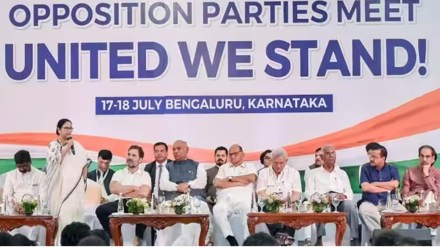It has begun well, no doubt, but whether the Opposition unity efforts would end well is something that even the proponents of the move are perhaps not sure of. Towards the end of a media interaction by Opposition party leaders on Tuesday, a question was popped up about what the seat-sharing formula might be, or how it would be arrived at. The silence that echoed back from the stage spoke volumes about the huge distance the alliance has to cover. Of course, these are early days and subsequent meetings might offer more clarity, but serious doubts linger about how most of these parties who call each other names in their respective states would be able to put together a united front at the central level. Even if they manage to do that, will they be credible enough?
For example, many might term the apparent bonhomie between Mamata Banerjee and Rahul Gandhi on Tuesday as nothing more than playacting as it comes just a few days after Congress party leaders alleged that Trinamool Congress was behind the murder of some of its party workers during the recent panchayat elections. And worries persist over the nettled relationship and domain warring between the Congress and the Aam Aadmi Party. Politics is, of course, the art of impossible, and for now, leaders of 26 Opposition parties have done a smart job of finding a catchy name for the new alliance.
The acronym INDIA (Indian National Developmental Inclusive Alliance) is a clever one, no doubt. The more encouraging sign is the Congress’s willingness to come off the high horse. Contrary to its earlier stand that it must lead any alliance, the party has now stated it is not hungry to grab power for itself. This is a sign of maturity—sorely missing so far—and may be a comforting factor for other parties. There is no doubt, however, that the Congress will have to play a large role for any such alliance to succeed. So, to maintain its relevance, the party needs to sort out its internal issues first. As the Karnataka elections showed, it needs a strong leadership at the state levels. It is important for the high command to prevent the kind of debacle that saw Punjab and Madhya Pradesh slip from the party’s grasp. Leadership tussles have been festering in Rajasthan and Chhattisgarh, two states that are up for Assembly polls later this year, and need to be addressed. Also, while he doesn’t hold any official position, Rahul Gandhi will obviously remain the face of the party. While he has come out of the caricatured image of a non-serious political dilettante, Gandhi still has a long way to go beyond his Bollywoodish slogans about “nafrat ke bazaar mein mohabbat ki dukaan khol raha hoon.”
Ultimately, the goal of a politician is to gain power to further an agenda or ideology. Being smart on social media, taking the moral high ground or touchy-feely politics are certainly not enough to get votes. Above all, the arrowhead of purpose for the alliance can’t be just anti-Modi rhetoric. India’s electorate would want to hear an alternative narrative for growth, for social harmony, etc. That has been missing so far. Although descriptions like “unanimity” and “common purpose” were repeatedly employed from the stage by several leaders, battle-readiness as a cohesive force will forever remain a work in progress unless INDIA presents a credible alternative vision to the voter.
